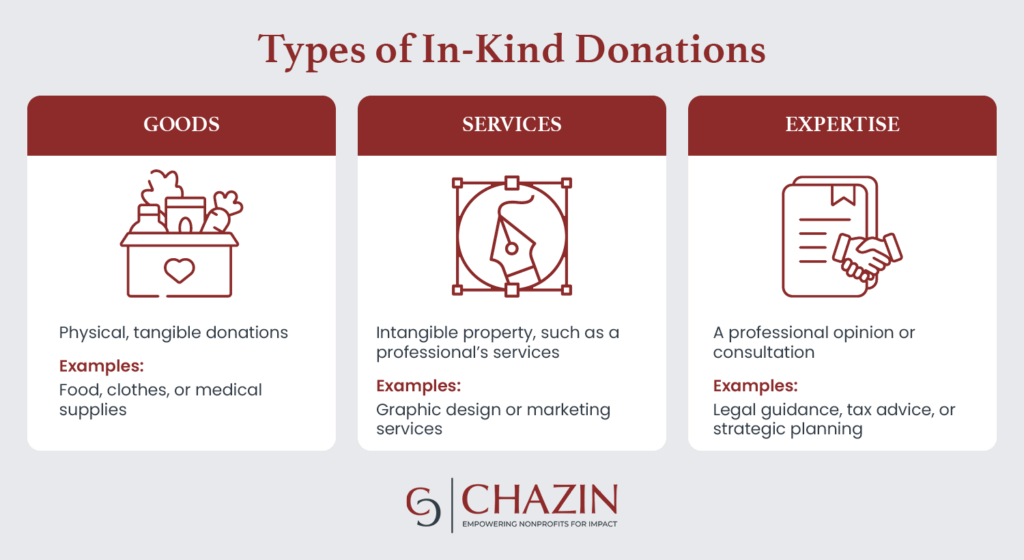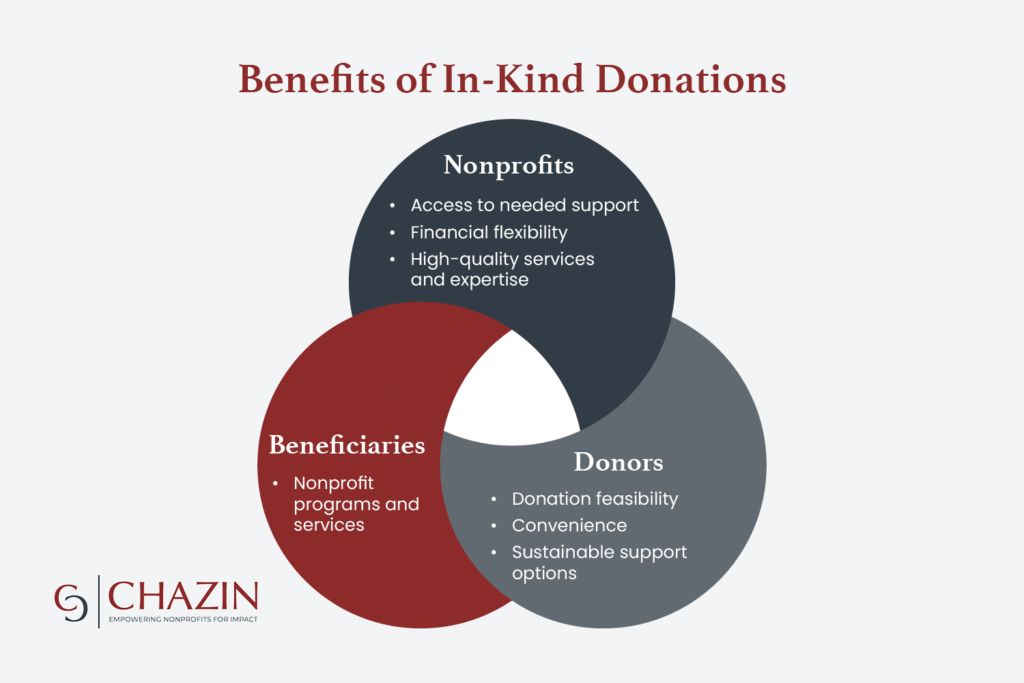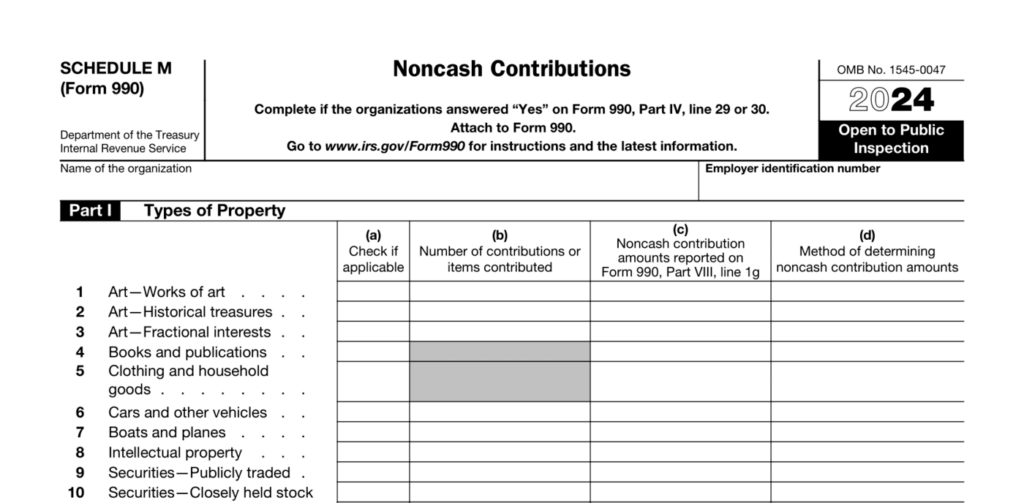
Most people think of accounting as a strictly monetary process. However, nonprofits worldwide receive many types of donations, and sometimes, they need resources beyond financial support.
In-kind donations provide numerous benefits to organizations that require goods or services for their mission-critical work. Plus, in-kind gifts are a popular way for donors with limited budgets to give.
In fact, a report published by the University of Albany indicated that U.S. donors contribute approximately $58 billion worth of in-kind donations each year. If you’re ready to tap into this form of support and report it properly in your budgeting and bookkeeping processes, this guide is for you.
What Is An In-Kind Donation?
An in-kind donation is a non-monetary gift, such as goods and services, given to a nonprofit organization by individuals or for-profit entities. The Internal Revenue Service (IRS) refers to these gifts as “noncash contributions,” which can include any donated asset other than monetary funds.
Noncash donations may be given freely or at a discounted rate. Conversely, the donor might pay for the good or service on the nonprofit’s behalf.
Types Of Noncash Donations
In-kind donations can be broken down into the following categories:

- Goods: In-kind donors can give physical, tangible donations either directly to beneficiaries or to your nonprofit (for use in fulfilling its mission). In fact, 81% of donors contribute food or other goods to nonprofits, such as canned vegetables to a food bank or dog toys to an animal shelter.
- Services: Noncash donations also include volunteered time, such as pro-bono legal work or free graphic design services. 68% of total in-kind giving comes from individuals volunteering, primarily with local organizations.
- Expertise: Instead of offering their services, some professionals may donate their expertise by serving as consultants. For example, a professional may offer tax advice or strategic planning at no cost to your nonprofit.
Nonprofits may receive every type of in-kind donation or only a few, depending on the organization’s mission, the gifts that would drive it forward, and the scope of its giving programs.
Benefits Of In-Kind Giving
Depending on the type of gift, nonprofits can use in-kind contributions for a variety of operational needs. Commonly, these gifts are used to support core programs and services. For example, a food bank may use donated food items to provide meals to families in need. These donations may also cover operational needs, such as kitchen supplies for cooking or tables for a dining area to serve meals.
Noncash gifts are also convenient for donors, meaning this form of giving drives benefits for all parties:

- Nonprofits receive:
- Access to needed support
- Financial flexibility
- High-quality services and expertise
- Donors experience:
- Donation feasibility
- Convenience
- Sustainable support options
- Beneficiaries gain:
- Nonprofit programs and services
In-kind donations can also help nonprofits raise awareness or run fundraising campaigns. For example, nonprofits may receive free access to an event venue, which can be used to host a fundraising gala or auction.
How to solicit noncash gifts
In-kind donation appeals require knowing what to ask for, who to ask, and how you’ll accept these gifts.
- Create a wishlist. Determine what types of in-kind gifts your nonprofit needs and create a wishlist to share with potential donors. Include any necessary context or notes about the exact types of donations you’re looking for. For example, an animal shelter might specify that they need unopened bags of dry pet food.
- Incorporate in-kind requests in fundraising appeals. Add your wishlist to your nonprofit’s website, social media posts, and other marketing channels. When reaching out to donors individually, tailor your appeal to the donors’ previous involvement. You might ask a recurring donor to donate their marketing expertise in lieu of their monthly cash donation, for example.
- Partner with willing companies. Companies donate approximately $4.1 billion worth of in-kind goods and services each year. Corporate sponsorships can support numerous fundraising needs with their vast resources, and these businesses are often willing to help out nonprofits as part of their corporate social responsibility (CSR) efforts or in return for brand promotion.
Note that standardized guidelines for in-kind donation solicitation, collection, and reporting are key to not only securing more support but also maintaining compliance.
5 Compliance Considerations For Noncash Donations
1. Gift Acceptance Policies
Although in-kind support includes a wide range of gifts, your nonprofit may not be able to use every donation it receives. For example, a healthcare organization can’t accept expired medication or opened packages of medical supplies.
How should your nonprofit decline gifts like these without seeming ungrateful to donors who mean well? Develop a gift acceptance policy that outlines:
- Acceptable gifts
- The condition of acceptable gifts, like new or gently used
- Gifts that can’t be accepted
- The circumstances for gift acceptance
- The procedure for recording these gifts
These guidelines simplify the gift acceptance process for your nonprofit and increase the likelihood that you’ll receive helpful gifts.
2. Fair Market Value
Fair market value (FMV) refers to the value of a good or service if it had been purchased by your nonprofit rather than donated. Since in-kind support should be recorded as revenue, this value is crucial for accurately reporting the value of these donations.
To find an item or service’s FMV, check with:
- The donor: Ask the donor to determine the value of an item or service.
- Major retailers: Research the typical price of an item by visiting the websites of major retailers.
- Similar providers: Contact providers of similar goods or services to get an estimate of the donation’s value.
For high-value donations, your nonprofit may need a professional appraisal. For example, you should consult an independent appraiser to determine the value of donated real estate or artwork.
3. Recording A Noncash Donation
Because in-kind support comes in many different forms, recording and reporting these gifts can be difficult. However, proper accounting for these contributions is necessary for tax filings, state regulation compliance, meeting the Generally Accepted Accounting Principles (GAAP), and passing a financial audit.
In your nonprofit’s chart of accounts, designate a separate revenue account for in-kind donations. Record each gift as revenue at fair value, but input its net value as zero since your nonprofit’s cash reserve doesn’t change. This process can be complex, so follow these steps to approach record-keeping efficiently:
- Record in-kind support immediately. Prompt record-keeping ensures your books accurately reflect your financial activity at all times. Additionally, you’ll be sure that every donation is accounted for by continually recording donations rather than catching up on your record-keeping after an extended period of time.
- Record the donation’s value in its functional expense account. For example, the expense side of a donation of marketing services should be recorded as Professional Services.
- Record the donation’s value in its separate revenue account. Following the example above, marketing services could be recorded under In-Kind Gifts – Services.
To ensure you accurately record these gifts, consider outsourcing accounting to a professional. This way, your books will be in the hands of a trustworthy professional while you focus on what matters most: your mission.
4. Donor Receipts
Donation receipts are required for both monetary and noncash donations, but there are specific requirements for in-kind gift receipts. According to the IRS, “a contemporaneous written acknowledgment” is necessary for gifts valued at $250 or more before donors can claim a charitable deduction on their federal income tax returns. These acknowledgments should include:
- Your nonprofit’s name
- A description of the contribution
- The date the donation was made
- A quid pro quo statement confirming the organization did not provide anything in exchange for the donation
The receipt or acknowledgment should not include an estimate of the donated item’s FMV. However, if your nonprofit provided goods or services in exchange for the in-kind donation, you must detail the value of what your organization gave and note whether you provided intangible religious benefits.
5. Form 990 Reporting
The annual tax return for 501(c)(3) organizations, Form 990, requires nonprofits to submit information about any noncash donations received throughout the fiscal year in Schedule M. This schedule’s instructions state that nonprofits must report the quantity and “financial statement amount of noncash contributions received by type of property.” This includes:

- Number of in-kind donations received
- The value of in-kind donations received
- The method of determining those values
- Confirmation of a gift acceptance policy
- Space for supplemental information
In addition to Form 990, review any state guidelines for in-kind donation reporting.
How to Streamline In-Kind Donation Collection And Reporting
Handling every step of in-kind contributions, from solicitation to reporting, can add a full-time workload to your nonprofit’s operations. To ensure these gifts support your work without taking time away from your mission-centric activities, it’s always best to consult a professional accountant.
Nonprofit accountants are familiar with the requirements and best practices for handling in-kind gifts. Professional nonprofit accounting services provide your organization with expertise in valuing, recording, and reporting every type of donation, as well as strategic advice for budgeting and making the most of your donors’ contributions.
For example, Chazin supplemented the internal team at St. Columba’s Episcopal Church with our nonprofit accounting expertise to:
- Streamline their chart of accounts
- Provide monthly reconciliations and financial statements
- Offer ongoing finance analysis and counsel
With the help of professional accounting expertise, St. Columba’s Episcopal Church saved $150,000 per year on finance-specific expenses and achieved a 70% increase in finance efficiency.
Additional Resources On In-Kind Donations
Diversify your nonprofit’s revenue sources by soliciting and collecting in-kind contributions. Once you’ve established a wish list and gift acceptance policy and the donations start rolling in, consult a nonprofit accountant to handle the rest of the process.
In the meantime, explore the following resources to keep growing your nonprofit accounting knowledge:
- Streamlining Audits With PBC Checklists: What You Need To Know. In-kind contributions are just one of many financial factors you’ll need to include if your nonprofit is approaching an audit! Learn how to prepare with a checklist in this guide.
- Key Audit Strategies For Nonprofits: Ensuring A Smooth And Uneventful Audit. Beyond knowing what to provide, there are some key strategies your nonprofit can employ to ensure your audit goes smoothly. Check out our list of key strategies.
- The Crucial Role Of A Nonprofit Board Treasurer: Navigating Finances For A Purposeful Future. Nonprofit board treasurers hold the key to financial stability and sustainability. Explore their responsibilities in our comprehensive guide.


